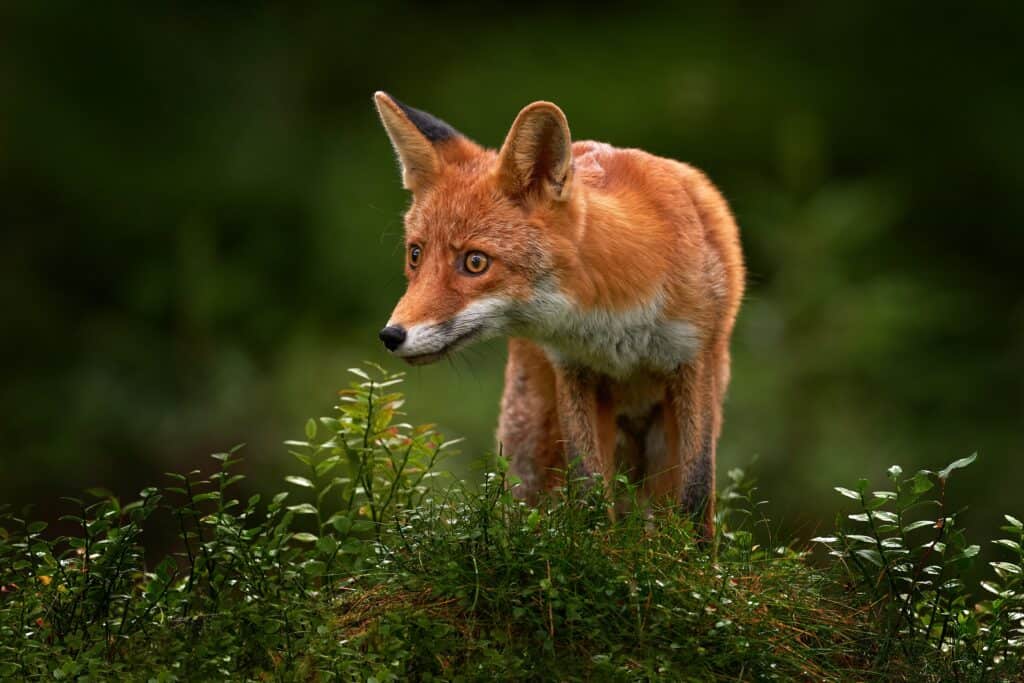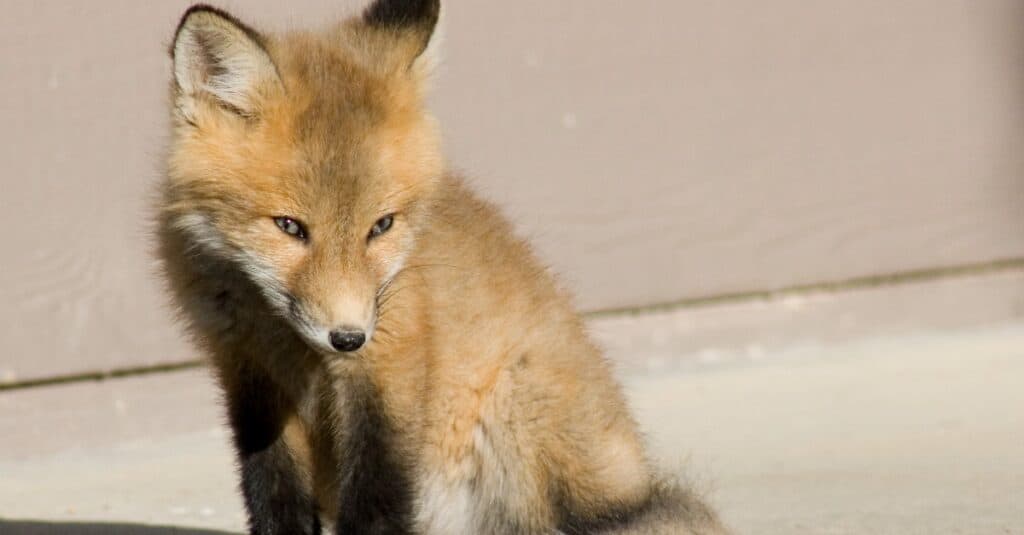Located in the western United States, Utah is home to an incredible variety of fascinating furry creatures, including a few different kinds of foxes. These elusive creatures are an integral part of Utah’s ecosystems and can be found living in the nooks and crannies of the state’s expansive mountain ranges, meadows, and deserts. With their lithe and slender frames, plush fur, expressive eyes, and inquisitive facial expressions, Utah’s foxes have a grace and beauty all their own. Let’s take a closer look at the different types of foxes in Utah and where they live!
1. Red Fox (Vulpes vulpes)

The red fox is the most common type of fox found in Utah.
©Ondrej Prosicky/Shutterstock.com
The most common type of fox in Utah is the red fox. Red foxes are active throughout the state all year round, although spring and summer is usually the best time to see them. Generally, they live in semi-open and open habitats. However, occasionally they also will live in heavily forested areas, and more recently red foxes have been moving into cities and suburban settings as well. They are most active at dawn and at dusk, although red foxes can be seen just about any time of the day or at night.
In spite of their name, not all red foxes are actually red. The most common color is their namesake reddish coat, but a red fox can also have fur that with different shades of red, silver, or black. Whatever their color, however, you can recognize red foxes by the white tip on the end of their fluffy tails. Red foxes also commonly have black “stocking” feet and black-rimmed ears. Even when they are not seen, red foxes are commonly heard throughout Utah. These classy-looking animals have unique vocalizations that range anywhere from barking to howling, screeching, and yipping.
Red foxes breed from the middle of January to the beginning of February and have babies sometime between March and May. Females typically have four to five baby foxes, which are called kits. The babies live in a separate den — called a natal den — that is dug into the ground or under rocks. When they are around eight to 12 weeks old they begin to hunt with their parents. By the autumn season, red fox babies are old enough to leave and find territories of their own.
2. Gray Fox (Urocyon cinereoargenteus)

The gray fox can be found in the shrubland and woodland areas of Utah.
©iStock.com/johnpane
The gray fox makes its home in the southern and central regions of Utah, typically in shrubland and woodland habitats. These foxes are usually nocturnal and tend to be shyer than red foxes. However, gray foxes can also be active at any point during the day. They build their dens in hollow areas like small caves, trees, and logs, beneath large boulders, or sometimes in the abandoned burrows of other animals. Gray foxes in Utah mate toward the end of winter and give birth to three to five kits between April and May.
Like their name, gray foxes have grizzled fur coats that are streaked with gray. There are black stripes along their tails and necks, as well as black on the tips of their tails. In addition, they have white or light reddish fur on their bellies, legs, and sides of their heads and necks. Their ears are sharply angled and they have pointy muzzles, which gives them a sharper look than the red foxes in Utah. Gray foxes also have uniquely curved claws that are longer than those of other foxes.
These powerful, hooked claws make gray foxes unique among other fox species because they are the only type of fox that can climb trees! Gray foxes often climb trees to stay safe from other larger predators. They can scramble up tall trunks that are nearly 60 feet tall, and jump from branch to branch with ease. Climbing trees is also useful for finding snacks high up in the branches.
3. Kit Fox (Vulpes macrotis)

The ears of a kit fox aid in keeping its body cooler in the desert heat in parts of Utah.
©iStock.com/jmhite
The kit fox is the least common type of fox in Utah. They mostly live in the western part of the state in desert habitats and are well-adapted to desert life. These tiny foxes have large ears that actually help them to stay cool during high temperatures. Any extra body heat a kit fox has can be released through their ears, keeping them nice and cool even in the hot desert. Kit foxes have short legs and fur on the bottoms of their feet for better traction as they speed through the desert brush to catch prey and escape predators.
Kit foxes don’t need to worry much about finding water. In fact, these adorable animals can go for months without drinking any water! Kit foxes survive on water and moisture from the food that they eat. They also live together in family groups with extra large territories so that when prey populations decrease during droughts, they still have plenty of areas to hunt for food. Moreover, kit foxes are nocturnal, so they are not usually out during the day when it is hot. Instead, they spend the day in subterranean dens where the temperatures are much cooler.
Kit foxes are incredibly efficient desert dwellers. These tiny foxes only weigh 4 or 5 pounds and have very delicate features that are almost cat-like in appearance. Their light brown or tan fur coats are sprinkled with rusty orange and flecks of silver, and the end of their long bushy tails is black. Kit foxes look very similar to swift foxes, but their ears are larger and closer together, their tails are longer, and their heads are more angled.
What to Do if You See a Fox in Utah
Seeing a fox in Utah can be a great experience, but it’s extremely important to practice safety and respect when you are viewing these incredible animals. If you see a wild fox in Utah, never try to feed it, approach it, or chase it. Be sure to supervise any pets with you at all times, and don’t ever leave your pets outside after dark. If you take your dog on a hike or in an open area with you, make sure they are on a leash. And of course, never let your dog play with a wild fox.
Foxes in Utah
| Red Fox (Vulpes vulpes) | Gray Fox (Urocyon cinereoargenteus) | Kit Fox (Vulpes macrotis) |
|---|---|---|
| Common throughout all of Utah; most active at dawn and at dusk, but can potentially be seen just about any time of the day or at night. | Central and southern Utah, typically in shrubland and woodland habitats; shy, can climb trees, typically nocturnal. | Deserts of western Utah; the least common type of fox in the state; nocturnal. |
| 39 to 43 inches long including the tail. | 30 to 40 inches long including the tail. | 28 to 33 inches long including the tail. |
| 6 to 15 pounds. | 7 to 13 pounds. | 4 to 5 pounds. |
| Reddish coat, but may also be any shade of red, silver, or black. | Grizzled fur coat streaked with gray; white or light reddish fur on belly, legs, and sides of head and neck; | Light brown, tan, or sandy-colored fur coat sprinkled with rusty orange and flecks of silver. |
| White-tipped tail, black “stocking” feet, and black-tipped ears. | Black stripes along tail and neck, and black-tipped tail; sharp, angled features. | Large ears, short legs, fur-covered paw pads, delicate cat-like features, and black-tipped tails. |
The photo featured at the top of this post is © iStock.com/Svetlana Belkina
Thank you for reading! Have some feedback for us? Contact the AZ Animals editorial team.






